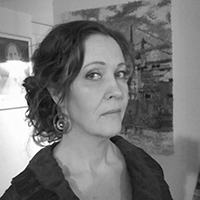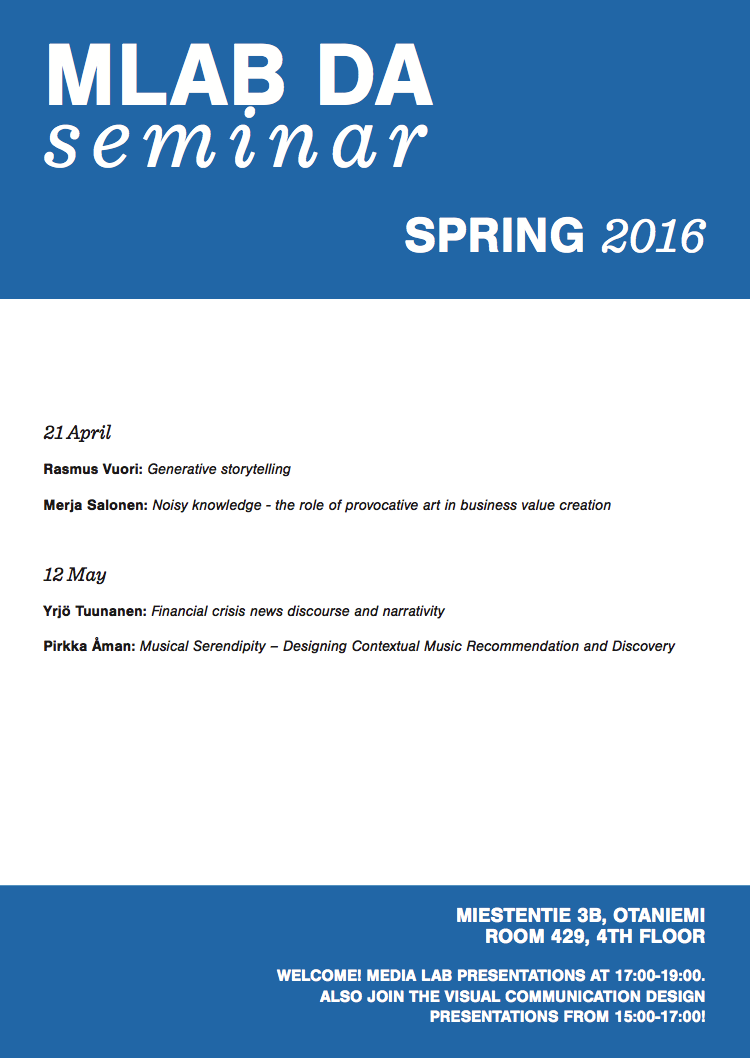
Call for articles – Helsinki Photomedia publication
As announced at the conference, we will make a peer-reviewed anthology that documents the key aspects of the conference theme Photographic Agencies and Materialities in the form of high-quality articles. The publication will be an open-access electronic publication consisting of a selection of approximately 10 –15 articles. The editors are professor Merja Salo, lecturer Hanna Weselius and doctoral student Marko Karo (Aalto ARTS), professor Mika Elo (University of the Arts Helsinki), Janne Seppänen and Asko Lehmuskallio (University of Tampere).
The publisher of the anthology is Aalto University School of Arts, Design and Architecture. The anthology will be available in the Aaltodoc publication archive: https://aaltodoc.aalto.fi and in the Aalto ARTS Books web bookshop: https://shop.aalto.fi.
The deadline for the articles is 5 June 2016.
Selection criteria:
- scholarly quality
- originality
- relevance to the theme
We will only consider completed articles for publication. Abstracts and drafts will not be passed to peer-review.
The author is responsible for the copyrights concerning the image materials used in the article.
Submission guidelines:
Optimal length: 6000 words.
File format: .doc or .docx for the text, pdf for the images
(NOTE: please collect all images in a separate pdf files and mark the placing of the images in the text with [Image 1], [Image 2], etc.). Maximum file size is 3 M.
Referencing system: Oxford System (known also as the Documentary/ Note system), see below.
Please attach a short bio (approximately 50 words) to your article.
The submissions should be sent to Helinä Kuusela helina.kuusela@aalto.fi prior to 5 June 2016.
Pdf: HPM2016 call for articles
Guide to the referencing system:
Footnotes
The First Note for a Source
In the text:
Note identifiers should be placed at the end of a sentence, and follow any punctuation marks (but precede a dash). If you use a long quotation (more than three lines of text), the note identifier should be placed at the end of the quotation.
Lake points out that a division began in the latter half of the nineteenth century with the doctrine of ‘separate spheres’.1
At the foot of the page:
When you reference a source for the first time, you must provide all the necessary information to enable the reader to locate the source.
- You should provide bibliographic information (information about the source). This includes:
- author(s) initial(s) and surname(s)
- name of the article, book or journal
- editors (if applicable)
- publisher name and location
- year published
- You should give exact page numbers if your reference is a direct quotation, a paraphrase, an idea, or is otherwise directly drawn from the source.
1 M Lake, ‘Intimate strangers’ in Making a Life: a People’s History of Australia Since 1788, V. Burgman and J. Lee (eds), Penguin, Victoria, 1988, p. 155.
Note Formatting
- Titles of publications should be italicised.
- Use minimal capitalisation for publication titles and for journal or book article titles.
- Article titles should be enclosed between single quotation marks.
- Use commas to separate each item of the citation and end with a full stop.
Second & Subsequent Notes
Second and subsequent references to the same source don’t need to be as detailed as the first note—they just need the minimum information to clearly indicate which text is being referred to.
With a single author provide all the necessary information in the first note. If you want to refer to the same source again, a simple method is to give the author’s name, the year of publication and the page number. For example:
1 I Reid, Higher Education or Education for Hire? Language and Values in Australian Universities, CQU Press, Rockhampton, 1996, p. 87.
2 …
3 Reid, p. 98.
If two or more works by the same author are referred to in the text, include the title:
1 E Gaskell, North and South, Penguin, Harmondsworth, 1970, p. 228.
2 E Gaskell, The Life of Charlotte Brontë, Penguin, Harmondsworth, 1975, p. 53.
3 Gaskell, North and South, p. 222.
Subsequent references to articles are done in a similar way:
17 M Doyle, ‘Captain Mbaye Diagne’, Granta, vol. 48, August 1994, pp. 99-103.
18 …
19 Doyle, Granta, p. 101.
Citing Different Sources
List information in the following order:
Book
- author(s) initial(s) and surname(s)
- title of book (italicised)
- publisher
- place of publication
- year of publication
- page number(s)
1 M Henninger, Don’t Just Surf: Effective Research Strategies for the Net, UNSW Press, Sydney, 1997, p. 91.
Article/Chapter in a Book Collection
- author(s) initial(s) and surname(s)
- title of article (single quotation marks)
- title of book (italicised)
- editor of book
- publisher
- place of publication
- year of publication
- page number(s)
2 M Blaxter, ‘Social class and health inequalities’ in Equalities and Inequalities in Health,
C Carter & J Peel (eds), Academic Press, London, 1976, pp. 6-7.
Journal Article
- author(s) initial(s) and surname(s)
- title of article (single quotation marks)
- title of journal (italicised)
- volume number
- issue number
- month of publication
- year of publication
- page number(s)
3 M. Doyle, ‘Captain Mbaye Diagne’, Granta, vol. 48, August 1994, pp. 99-103.
Electronic Source
A Website
- author
- name & place of sponsor of site
- date site was created or updated
- date of viewing
- URL
Electronic Mail Lists, Usenet Groups & Bulletin Boards
- author
- author’s identifying details (eg.email address)
- description of posting
- name of list owner
- date of posting
- date of viewing
- URL
A Document within a website
- author/editor
- title
- name of sponsor of site
- last date site updated
- date of viewing
- URL
Emails
These are cited the same as for personal communications
4 N Curthoys, ‘Future directions for rhetoric – invention and ethos in public critique’, in Australian Humanities Review. March-April 2001, viewed on 11 April 2001, <htttp://www.lib.latrobe.edu.au/AHR/archive/Issue-April- 2001/curthoys.html>.
Bibliography
Book
Reid, I Higher Education or Education for Hire? Language and Values in Australian Universities. CQUPress, Rockhampton, 1996.
Journal Article
Doyle, M ‘Captain Mbaye Diagne’. Granta, vol. 48, August 1994, pp. 99-103.
Web Document
Curthoys, N, ‘Future directions for rhetoric – invention and ethos in public critique’, in Australian Humanities Review, March-April 2001, viewed on 11 April 2001 <htttp://www.lib.latrobe.edu.au/AHR/archive/Issue-April-2001/curthoys.html>.






